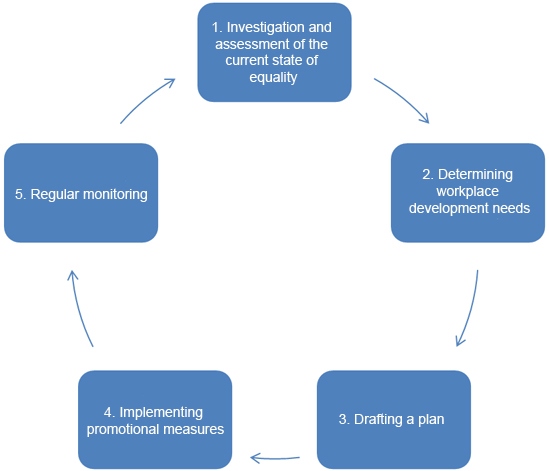

Employment relationship
Promoting equality
Employee equality must be promoted
The employer must actively promote equality among employees and discourage discrimination at the workplace. The aim is for the workplace to observe genuinely non-discriminating practices in recruitment, career advancement, assignment of job duties, decisions on pay and benefits, access to training and workplace community development.
In order to promote the equality of their employees, an employer must first assess the realisation of non-discrimination in recruitment and at the workplace. All different grounds for discrimination must be taken into account in the assessment. If necessary, the employer must develop specific non-discriminatory practices in working conditions and procedures for recruitment and HR decisions.
An employer with regularly at least 30 employees must have a plan in place to promote equality at the workplace. There is no set form for such a plan, but it must be available for verification and inspection.
The plan may be combined with another plan required for the workplace, such as the occupational safety and health policy or the gender equality plan.
Promotional measures and their effectiveness must be discussed with personnel or their representatives (shop steward or personnel representative). The personnel representative is entitled to be informed on request what measures the employer has taken to promote equality at the workplace.
Promoting equality is the employer’s responsibility
Workplaces with at least 30 employees are required to have an equality plan.
The employer must actively promote equality and develop genuinely non-discriminatory working conditions and practices. The aim is to incorporate the promotion of equality into regular workplace development. Promotion of equality may be combined with the hazard assessment provided for in the Occupational Safety and Health Act and the related occupational safety and health development process.
Non-discrimination begins with job ads
When announcing a vacancy, job applicants must not be required to have any personal characteristics or features that have no relevance for the work to be performed.
The employer must also carefully consider what information is collected about employees on job application forms. Asking applicants to list irrelevant personal characteristics and features such as marital status or children may prompt the assumption that such information will be used as criteria for selection.
Measures to promote equality

1–2: Chart the current state of equality at the workplace and identify development needs
The employer is required to evaluate the achievement of equality at the workplace. The purpose of the evaluation is to find the circumstances and procedures that prevent equality from being achieved. The evaluation leads to conclusions allowing the selection of appropriate measures to promote equality.
The implementation of non-discrimination at the workplace can be examined, for example, by means of personnel surveys or interviews or by reviewing personnel statistics and workplace practices from the perspective of non-discrimination. An employer can investigate the realisation of equality in recruitment by reviewing the recruitment practices of the workplace.
Achievement of equality must be assessed from the perspective of all the prohibited grounds for discrimination. The question of which grounds for discrimination are relevant for the workplace must be discussed with personnel or their representative.
The evaluation must cover all working conditions and practices followed in recruitment and HR decisions: whether the working conditions and procedures are non-discriminatory from the perspective of various groups at risk of discrimination. In evaluating equality, the employer must review procedures at least in
- recruitment
- assignment of job duties
- deciding on access to training
- deciding on pay and benefits
- deciding on responsibilities related to work and employment relationships.
The employer must note that grounds for discrimination may arise from personal characteristics the information concerning which is sensitive and whose handling at the workplace is therefore restricted by law.
3. Draft a plan for the required measures
Employers who have 30 or more regular employees must have a plan in place concerning measures to promote equality, i.e. an equality plan.
The employer may select the methods best suited to the needs of the workplace for promoting equality. The equality plan may be a separate plan or incorporated in any other plan required at the workplace, such as the gender equality plan under the Act on Equality between Women and Men, the personnel plan under the Act on Co-operation in Undertakings, or the occupational safety and health policy under the Occupational Safety and Health Act.
The content and extent of the equality plan are determined by the evaluation performed by the employer. The plan must include a report on the conclusions of the assessment of the equality situation and a description of how the conclusions have been reached. The conclusions must identify the needs of the workplace and its concrete measures for achieving equality as well as possible problems in the implementation of equality.
According to the amendment to the Non-Discrimination Act that entered into force on 1 June 2023, the workplace equality plan must also include a report of the conclusions drawn from the equality assessment. The transition period for this provision is two years.
4. Measures to promote equality
The employer must promote equality through action deemed necessary because of the development points and eventual problems identified in the evaluation. The nature and extent of such action depends on the needs of the workplace and the resources available.
Promotional measures are concrete actions that affect the actual situation regarding equality at the workplace. For example, arranging the work so as to take the needs of employees at risk of discrimination better into account. Actions may also include support for vulnerable employees, such as support (known as positive discrimination) for the elderly or the incapacitated.
Measures to prevent discrimination and harassment also qualify. Such measures include procedures for processing suspected discrimination at the workplace and non-discrimination training for employees and supervisors.
5. Monitor the measures to see if they are sufficient
The employer must monitor the equality situation at the workplace continuously and evaluate whether the measures taken have had the desired effect. If necessary, the employer must revise or further specify the measures to promote equality.
Related topics in Tyosuojelu.fi
This website is part of the European Commission's Your Europe portal. Did you find what you were looking for?


